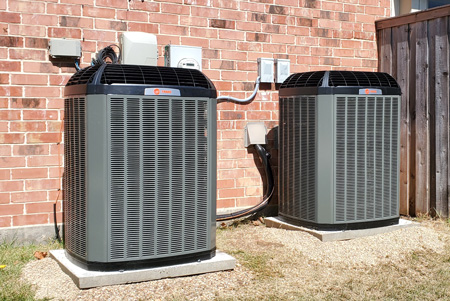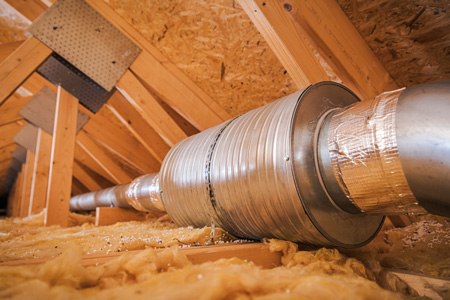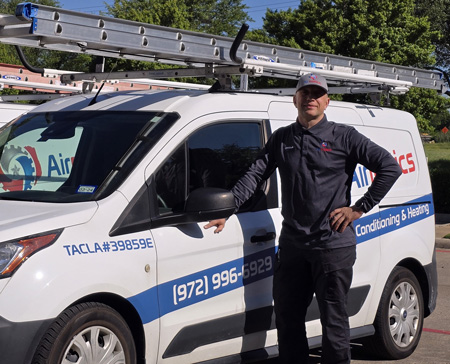Thinking about installing a new central air conditioner in your Texas home or commercial property? Whether you’re in Plano, Dallas, or Frisco, it’s important to understand what impacts your installation cost and how much you should realistically expect to budget in 2025. Central AC costs can vary widely, and several factors determine air conditioning expenses, including the type of system you choose, the size of your home, and the efficiency rating of the unit.
In this article, we’ll break down current AC installation costs across major North Texas cities, explain the key cost factors, and share real pricing examples for brands like Trane, Bosch, CHAMPION, and Cooper-Hunter. We’ll also discuss central systems as a primary category of residential air conditioning, highlighting their prevalence and associated costs of installation.
Introduction to Central Air Conditioning

Central air conditioning is a whole-home cooling solution designed to keep your indoor environment comfortable, even during the hottest Texas summers. Unlike window units or portable air conditioners, a central AC system circulates cooled air evenly throughout your entire home using a network of ducts. This not only provides consistent comfort but also helps improve indoor air quality and energy efficiency.
Installing central air is a significant investment, but it comes with long-term benefits. Homeowners enjoy increased property value, lower energy bills with modern energy efficient systems, and the convenience of controlling the temperature in every room. When considering installing central air unit, it’s important to evaluate factors such as:
- the type of system,
- the size of your home,
- and whether you have existing ductwork.
These elements all play a role in determining the total cost and efficiency of your new cooling system.
By understanding the basics of central AC, you can make informed decisions that ensure your home stays cool and comfortable for years to come.
Types of Air Conditioning Units
When it comes to cooling your home, there are several types of units to choose from, each with its own set of advantages. The most common options include:
- split AC systems,
- packaged systems,
- ductless mini split systems.

Split systems are the most popular choice for residential homes. They feature an indoor unit that works with a single outdoor unit to deliver cool air through ductwork. This setup is known for its reliability and energy efficiency, making it a great fit for homes with existing ducts.
Packaged systems combine all the components – compressor, condenser, and air handler into a single outdoor unit. These are often used in homes with limited indoor space or in commercial properties, offering a compact solution that still delivers powerful cooling.
Ductless mini split systems are ideal for homes without existing ductwork or for adding cooling to specific rooms or additions. These systems consist of one or more indoor units connected to an outdoor unit, providing flexible installation options and excellent energy efficiency. Because they don’t require ducts, ductless mini-splits can help reduce energy loss and lower the costs of operation.
When selecting an AC unit, consider factors like efficiency ratings, ongoing operating costs, and the specific cooling needs of your home. Choosing the right type of system can help you maximize comfort while keeping energy bills in check.
Central Air System Components

A central AC system is made up of several key components that work together to keep your home cool and comfortable. At the heart of the system is the air conditioner, which removes heat from the indoor air. The air handler then circulates this cooled air throughout your home via a network of ducts.
Ductwork is essential for distributing coolness efficiently to every room. Well-designed and properly sealed ducts help maintain the system’s efficiency and ensure even cooling. The thermostat acts as the control center, allowing you to set and maintain your desired temperature with ease.
Other important parts include:
- filters, which trap dust and allergens;
- coils, which help transfer heat;
- fans, which move air through the system.
Regular maintenance of these components, such as changing filters and cleaning coils, helps your central AC system operate efficiently, reduces the risk of breakdowns, and extends the life of your air conditioner.
By understanding how each part of your central AC system works, you can better appreciate the importance of quality installation and ongoing care.
Average Central AC Installation Cost in Texas (2025)
Texas homeowners can expect to pay between $6,000 and $14,000 for a full central AC replacement (equipment + installation), depending on unit size, efficiency, ductwork, and more. The price range also depends on the cooling capacity and efficiency of the central air conditioner unit selected.
Typical unit-only replacements (no ductwork) cost about $3,000 to $5,000. Choosing a new AC unit with higher efficiency may involve a higher upfront cost, but it can reduce long-term opera costs.
Location | Low End | Average | High End |
|---|---|---|---|
Plano | $1,950 | $5,200 | $9,750 |
Frisco | $1,948 | $5,200 | $9,740 |
Allen | $1,747 | $4,700 | $8,739 |
McKinney | $1,869 | $5,000 | $9,346 |
Southlake | $1,800 | $4,800 | $9,000 |
Grapevine | $1,785 | $4,800 | $8,925 |
Dallas | $1,800 | $4,900 | $9,000 |
Lewisville | $1,900 | $5,000 | $9,500 |
Irving | $1,800 | $4,800 | $9,000 |
Carrollton | $1,823 | $4,900 | $9,116 |
Texas Avg. | $2,000 | $5,500 | $10,000+ |
U.S. Avg. | $2,500 | $5,750 | $12,000 |
Source: Aggregated estimates from HomeAdvisor, Angi, HVAC.com, and 2025 local HVAC provider data across North Texas cities.
These estimates cover residential 3–5 ton systems with standard efficiency (14–16 SEER2). Prices rise with larger capacities or high-efficiency models. Investing in a high-efficiency central air conditioner unit can improve the efficiency of the system and lower energy costs over time.
What Affects Your Central AC Installation Cost?

Several factors impact the final cost of air conditioning installation, including the type of ac units selected and the efficiency of the air conditioner’s components.
- System size: The size of the system needed depends on your home’s square footage and insulation. A pre-installation evaluation by an HVAC company will help determine the appropriate size and type of ac units for your home.
- Efficiency rating: Higher SEER2 ratings mean greater energy efficiency, which can lower your utility bills. A higher SEER2 rating improves the air conditioner’s system efficiency and reduces overall energy usage.
- Ductwork requirements: If your home lacks existing ductwork, installation costs will be higher. Different air conditioning systems, such as ducted vs. ductless, have varying installation needs and costs.
- Brand and model: Premium brands or advanced models may cost more upfront but can offer better performance and reliability.
- Labor and location: Labor rates and regional pricing differences can also affect the total cost.
System Size (Tonnage)
- 1.5 Ton: $2,500–$4,500
- 3 Ton: $3,400–$5,400
- 5 Ton: $4,300–$6,800
Bigger homes need more cooling power, so expect to pay more for larger systems.
Efficiency Rating (SEER2)
- 15 SEER2: Entry-level (now the legal minimum in Texas). SEER2 stands for ‘seasonal energy efficiency ratio,’ which measures how efficiently an air conditioning system operates over a cooling season.
- 16–18 SEER2: Balanced performance & savings
- 20+ SEER2: High-efficiency systems (usually variable-speed). Higher SEER ratings typically come with a higher initial price but can save money in the long run on energy bills.
High-SEER systems save energy but can cost $2,000+ more upfront. Higher-efficiency AC systems may cost $1,000 to $2,000 more initially but can save hundreds per year in energy bills.
Ductwork Requirements
- Replacing ductwork adds $3,000 to $5,000 or more
- Keeping existing ducts can cut thousands off the bill. The installation of ductwork typically ranges from $500 to $7,500.
For homes without existing ductwork, ductless air conditioning systems are an efficient alternative, providing cooling without the need for major renovations.
Brand and Features
- Smart thermostats, air quality add-ons, or zoning increase cost, but choosing an energy efficient model or high efficiency air conditioners can qualify for rebates and provide long-term savings
- Premium brands offer better warranties and performance
Residential vs. Commercial AC
- Small office buildings: $8,000–$17,000
- Larger retail or industrial: $20,000–$40,000+
- Rooftop or packaged units often require cranes and custom ducting
Labor Costs and Installation Process

The cost to install central air conditioning isn’t just about the equipment. It also includes labor, which can be a significant part of your total investment. Labor costs for central air installation in Texas typically range from $75 to $250 per hour, depending on the complexity of the job and the experience of the HVAC contractor. The total installation cost can vary widely, from $3,000 to $10,000 or more, based on the size of your home and the type of central air system you choose.
The installation process begins with a thorough assessment of your home’s cooling needs, including a load calculation to determine the right system size. Next, your HVAC contractor will help you select the best system for your budget and comfort requirements. Installation involves setting up the air conditioner, air handler, ductwork (if needed), and thermostat, followed by testing to ensure everything operates efficiently.
Hiring a qualified HVAC contractor is essential for a successful installation. A professional will ensure your central air system is installed correctly, which helps prevent future issues like high energy bills, uneven cooling, or premature system failure. Investing in quality installation pays off with reliable comfort and lower operating costs for years to come.
Brand Pricing Examples
Trane
Durable and efficient, but pricier than most.
- 3 Ton, 16 SEER2: $4,000–$6,500 installed
- 5 Ton, 20+ SEER2: $9,000–$10,500 installed
Bosch
Inverter-driven systems known for quiet, efficient operation.
- 3 Ton Heat Pump System: ~$10,000–$15,000 installed
- Ideal for homeowners prioritizing high-end comfort
CHAMPION
Solid mid-range brand. Excellent value.
- 3 Ton, 14 SEER: ~$5,100 installed
- 3 Ton, 17 SEER Two-Stage + Gas Furnace: ~$8,600 installed
Cooper & Hunter
Budget-friendly ductless systems. Good for additions or small commercial use.
- Dual-zone Mini-Split (2.5 Ton, 22 SEER): $2,700–$4,000 (equipment only)
- Full install can cost $3,200–$10,500 depending on zones
Why 2025 Prices Are Higher Than Previous Years
- New refrigerant (R-454B) regulations require redesigned equipment
- Efficiency standard changes (15 SEER2 minimum in Texas)
- Labor and material costs have increased post-2020. The demand for HVAC services peaks during summer months, affecting contractor availability.
Installing a new central air system is especially important in Texas homes, where insulation quality determines how well a home retains heat. An efficient system ensures consistent comfort during a heat wave and meets the latest standards.
Tip: If you’re replacing an older R-410A unit, you’ll need a fully compatible new system.
Financing Options for install Central Air in Texas
Installing central air conditioning is a major investment, but Texas homeowners have several financing options to help manage the upfront cost. Home equity loans and home equity lines of credit (HELOCs) are popular choices, offering lower interest rates and longer repayment terms by using your home as collateral. These options can make it easier to afford a new, energy efficient central air system.
Personal loans are another option, providing quick access to funds without requiring collateral, though they may come with higher interest rates. Many utility companies and HVAC manufacturers also offer rebates and incentives for installing energy efficient systems, which can help offset installation costs and reduce your overall investment.
Before deciding on a financing method, compare interest rates, repayment terms, and eligibility requirements to find the best fit for your budget. Taking advantage of available rebates and incentives can make installing central air more affordable while helping you save on energy in the long run.
Permits and Regulations in Texas
When installing a central air conditioning system in Texas, it’s important to follow all state and local regulations to ensure your system is safe, efficient, and up to code. Homeowners are required to obtain the necessary permits before starting installation, and all work must be performed by a licensed HVAC contractor. The Texas Department of Licensing and Regulation (TDLR) oversees the licensing of HVAC professionals and enforces standards for air conditioning installations.
Local authorities may have additional requirements, such as zoning restrictions, noise ordinances, or environmental guidelines. Your HVAC contractor should be familiar with these regulations and can help you navigate the permitting process. By ensuring your central air conditioning system is installed according to all applicable codes and standards, you protect your investment and ensure reliable, efficient cooling for your home.
Always consult with your local building department and a licensed HVAC contractor before beginning any central air installation project to avoid costly delays or compliance issues.
Rebates and Tax Credits (2025)
You may qualify for federal tax credits or local Texas utility rebates if you install a high-efficiency system (16+ SEER2). These can offset $300–$1,200 or more from the total cost. You can look for equipment rebates and tax credits when financing a central air installation.
Warning: Cheapest Isn’t Always Best
Going with the lowest bid can cost you more in the long run. Hiring a qualified HVAC professional for your HVAC installation ensures safety, efficiency, and long-term reliability. Always look for:
- Licensed & insured HVAC contractors
- 10-year manufacturer warranties
- Strong reviews & references
Ready for a Quote in North Texas?
AirMatics, a trusted HVAC company serving North Texas, proudly serves Plano, Frisco, Allen, McKinney, Dallas, Southlake, and beyond with expert AC installation. We install Trane, CHAMPION, Bosch, and more.
FAQs: Central AC Installation in Texas
Typically 12–15 years. Regular maintenance helps extend it. The average lifespan of a well-maintained central air unit is typically 15 to 20 years.
Yes, if the ducts are in good shape and properly sized.
Usually within 1–3 days after approval. Emergency options available.
A window unit is a simple, cost-effective cooling solution that is easy to install and ideal for small rooms or specific spaces. Central air systems, on the other hand, require more complex installation and are better suited for cooling an entire home. Window units are generally more affordable upfront, while central air provides more consistent cooling throughout larger areas.